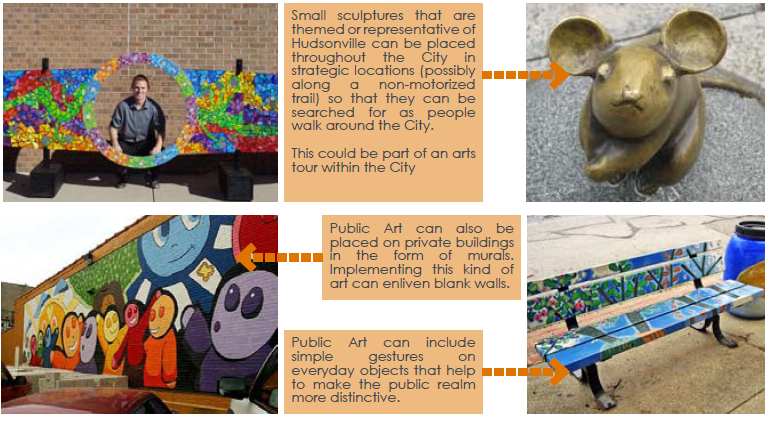A city that embraces its rural agricultural heritage and balances the past with endearing civic spaces, iconic public art, buildings that respond to a rural small town character, and infrastructure that encourages sustainable design.
Build Village Green
Continue to be proactive in the development of the downtown village green by securing funding sources, seeking private-sector collaboration, acquiring necessary land, designing and constructing new streets, and designing and constructing the park.

Increase Street and Streetscape Aesthetics
Continue streetscape improvements along Chicago Drive. Initiate similar improvements along 32nd Avenue and other key streets within the downtown that include installation of pedestrian-scaled lighting, bike racks, street trees, landscaping, and banners. All street improvement projects should include elements that increase the aesthetic appeal of the street. A longer term implementation project is to remove overhead power lines along Chicago Drive.

Install Great Public Art
Collaborate with the private-sector, citizens, and foundations to acquire, commission and install public art throughout the City - specifically in civic spaces, parks, and plazas. While some art may be temporary, it is important to strive toward permanent installations that can be emblematic of Hudsonville.

Promote Great Public Art
Maintain an Arts Advisory Council to oversee, coordinate, advise, and plan the commissioning and acquisition of public art. Council should also oversee arts programming, promotion, and education within the City. Also consider building walking tour apps for mobile devices that can be used to take independent tours of the City’s public art.

Use Distinctive Design to Create Small Town Character
Continue to expand, build upon, and refine the architectural foundation established by the Hudsonville Architectural Elements Portfolio (ADEP) and the Downtown Master Plan to create innovative, beautifully designed, appropriately-scaled and context-sensitive buildings. Do this by focusing on the importance of design and aesthetics in all new and remodeled buildings AND by collaborating with developers and their architects to understand the importance of architectural design within the City. Consider using historic preservation as a tool to preserve historic homes in strategic locations within the City.

Promote City Building and Urban Design
Design and construct infrastructure improvements downtown that create small blocks with a network of connected streets, terminated and deflected vistas, and significantly enhanced pedestrian amenities.

Build Sustainable Buildings
Encourage the design and construction of sustainable buildings that are energy efficient, use fewer resources, and sited within a walkable context (to promote a variety of ways to get to them). One way to do this is to promote the USGBC’s LEED certification, although sustainable buildings can be built without this certification.

Build Sustainable Landscapes and Streetscapes
Promote the design and construction of elegant stormwater infrastructure - Stormwater As Art - that can not only provide stormwater solutions, but also public realm enhancements. One way to do this is to create a City-wide policy that all street improvements include sustainable and aesthetically pleasing stormwater solutions. This new policy should include a toolkit of solutions that can be applied to the City’s infrastructure.
